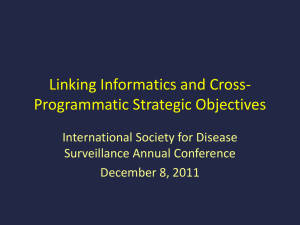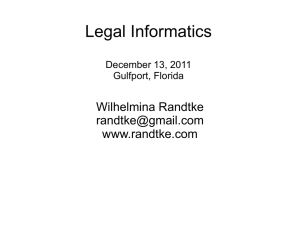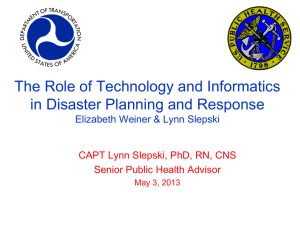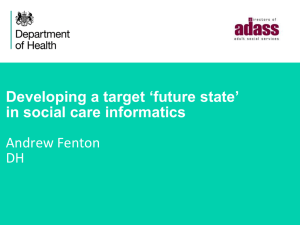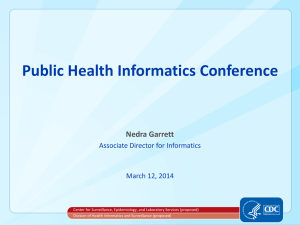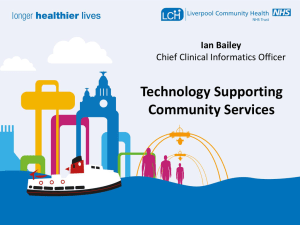The Role of Public Health in the Emerging Information Marketplace
advertisement
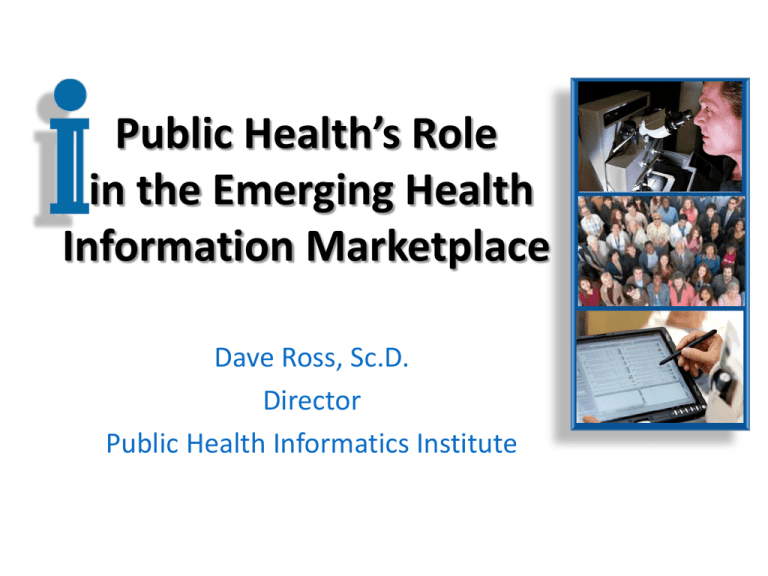
Public Health’s Role in the Emerging Health Information Marketplace Dave Ross, Sc.D. Director Public Health Informatics Institute Paper Kills © 2012 Public Health Informatics Institute Topics for Discussion Where Are We Today? e-Health e-Public Health e-Citizen What Might the Future Bring? Call for Collective Action © 2012 Public Health Informatics Institute My Overriding Message • Our collective challenge: To support and accelerate the transformation of public health practice in the e-health era by building on public health’s unique “infomediary” role. • Our goal: improve population health with information outputs and outcomes that people care about. © 2012 Public Health Informatics Institute © 2012 Public Health Informatics Institute National Health Challenge Information Assault New Partners e-Health e-Public Health FORCES SHAPING PUBLIC HEALTH © 2012 Public Health Informatics Institute Life Expectancy at birth Our National Health Challenge © 2012 Public Health Informatics Institute Total Expenditures on Health per capita (US $) Smart Phone Culture • 15-second rule • 24-hour news cycle © 2012 Public Health Informatics Institute © 2012 Public Health Informatics Institute © 2012 Public Health Informatics Institute © 2012 Public Health Informatics Institute © 2012 Public Health Informatics Institute © 2012 Public Health Informatics Institute Modern Measurement Challenges (Big) Data Issues – 5Vs Variety Sources Formats Types Structures Transmission Velocity Creation/generation Transmission Computation Consumption Source: Herman Tolentino, Sridhar Papagari, Kate Glynn © 2012 Public Health Informatics Institute Volume Veracity Storage Retrieval Computation Consumption Source (trust) Content Voids Completeness Comprehensiveness Fragments Representativeness 15 Community-Centered Health Information MICA - (Missouri Information for Community Assessment) :: 16 Information Model View of Public Potential for Collaboration among PHSSR, CQI, & Informatics INFO-MEDIARY ROLE © 2012 Public Health Informatics Institute Information Model: The Why’s and What’s Manage administrative operations of the public health department Support public health actions and programs Improve the public’s health Protect the public’s health Respond to public health threats © 2012 Public Health Informatics Institute Public Health Goals and Their Associated Functions PUBLIC HEALTH GOAL Improve the public’s health Protect the public’s health Respond to public health threats FUNCTION: ASSESS Assess community health Assess the environment for hazards Assess potential public health threats FUNCTION: PLAN Plan to improve community health Plan to protect the public’s health Plan and prepare for public health threats FUNCTION: ACT Act to improve community health through targeting individuals Act to control and mitigate public health hazards Act to respond to public health emergencies Act to enforce public health laws and regulations Act to respond to outbreaks Evaluate…actions for protecting the public’s health Evaluate…responses to public health threats Act to improve community health through targeting communities and populations FUNCTION: EVALUATE © 2012 Public Health Informatics Institute Evaluate…actions for improving the public’s health Public Health Support and Administrative Operations Functions SET OF SUPPORTING Support public health actions and programs FUNCTIONS FUNCTIONS Collect, maintain, and analyze public health data Provide legal support to the public health department Provide epidemiological, statistical, and analytical support Provide support for grants, contracts, and cooperative agreements Provide laboratory services and diagnostic support Provide informatics support Communicate public health information Provide executive leadership Manage administrative operations of the public health department Manage finances Manage human resources Manage supplies Provide information technology services Manage facilities and other capital resources Administer vital records © 2012 Public Health Informatics Institute Visit to learn more © 2012 Public Health Informatics Institute Collaborative Requirements Development Methodology © 2012 Public Health Informatics Institute Where the work takes place Person who does the work Decision point Capture in the work flow logic and requirements through nontechnical modeling Discrete work activity or task Capture rules, comments and feedback © 2012 Public Health Informatics Institute Informatics Baked In • Good informatics builds around CQI concepts – We want you to use CRDM – We want informatics projects to use CQI • Good informatics should enable public health services and systems research • Good informatics will build public health agency information capabilities © 2012 Public Health Informatics Institute “ Skate to where the puck is going, not where it is. ” Wayne Gretsky • What is our role in an era of Google Flu Trends? • Will your agency use big data? • Will your agency have access to big data technologies? • Will you use shared services (SaaS, PaaS)? • Citizen agents via personal health information tools FUTURE INFORMATION ROLE © 2012 Public Health Informatics Institute © 2012 Public Health Informatics Institute © 2012 Public Health Informatics Institute © 2012 Public Health Informatics Institute © 2012 Public Health Informatics Institute Guiding Principles • Collaborate and drive consensus – Mutual contributions, shared implementation • Plan boldly, implement incrementally – Need to be both strategic and tactical • Understand we are transforming practice – Informatics and IT are tools © 2012 Public Health Informatics Institute PUBLIC HEALTH’S ROLE IN THE EMERGING HEALTH INFORMATION MARKET PLACE © 2012 Public Health Informatics Institute 1. Make data sharable A. Embrace the Info-mediary role i. Using data means we have a focus on interoperability & information integration B. Make data, information & analytic tools widely available to public health, healthcare, payers and community partners i. Create public use datasets ii. Support and use all payer claims datasets © 2012 Public Health Informatics Institute 2. Focus on neighborhood health information A. Establish multi-site collaborative projects B. Establish agency-based i3-Labs (innovation & implementation informatics Labs) C. Study and evaluate community interventions and the role information plays in them © 2012 Public Health Informatics Institute 3. Establish an NCQA for social determinants of health A. Establish a research base for linking social determinants with desirable health and community resilience metrics B. Provide analytic support C. Initiate “blinded benchmarking” to provide feedback on community-based program effectiveness © 2012 Public Health Informatics Institute Next Steps © 2012 Public Health Informatics Institute Q&A ENOUGH OF ME, LETS TALK! © 2012 Public Health Informatics Institute Work Areas of the Public Health Deliver Individual Health Services Provide Laboratory Services Measure and Monitor Population Health Regulate Facilities, Workers, Systems and Activities Provide Environmental Health Services Prepare and Respond to Health Threats and Hazards Develop Policies and Plans and Evaluate Public Health Services and Programs Conduct Community Based Assessments and Interventions Communicate Health Information Provide Public Health Operations Support DRAFT V14.0 © 2012 Public Health Informatics Institute NOT FOR DISTRIBUTION Getting the right information, to the right person, at the right time to support them doing something constructive to advance health © 2012 Public Health Informatics Institute

